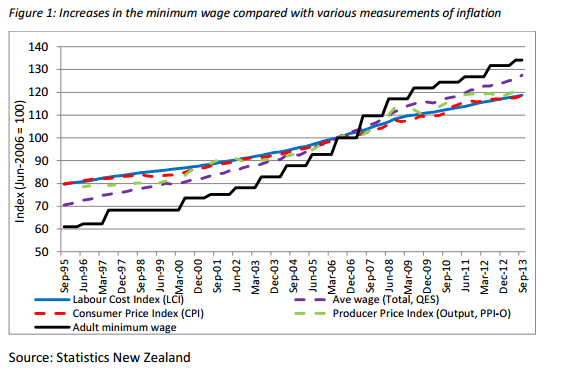The the 1 April 2014 the minimum wage increased by 50 cents to $14.25 per hour. Campaigners for a “Living Wage” of $18.80 per hour which is the cost to feed two adults and two children. The following is excerpts from various reports/articles that investigate evaluate minimum wage rate and the living wage.
Against
The main case against a legal minimum wage is that it increases unemployment because it interferes normal functioning of the supply and demand rules of labour market.
For
Legal minimum wages are a fraction of the average wage – so their impact in negligible. And any disadvantage in employment levels are outweighed by the improved living standards of low-income workers.
References on the effects of a minimum wage
- In 2006, the International Labour Organization (ILO) argued that the minimum wage could not be directly linked to unemployment in countries that have suffered job losses.
- 2010, the OECD stated that teen unemployment by “lowering the cost of employing low-skilled youth” through a sub-minimum training wage.
- In 2006 a study carried out by the Fiscal policy Institute in the U.S. showed that businesses’ annual and average payrolls grow faster and employment grew at a faster rate in states with a minimum wage. The study showed a correlation, but did not claim to prove causation
New Zealand’s minimum wage compares well with other countries
Excerpt from page 7
..”New Zealand has a high minimum wage compared with similar countries. Among the OECD countries, four countries (Australia, Luxembourg, France and Belgium) had higher minimum wage rates than New Zealand in 2012 in terms of absolute wage level. If transferred to annual income assuming a standard working week for each country, only two other countries have a higher annual income for a minimum wage worker than New Zealand (Australia and Luxembourg)”.
The minimum wage is keeping up with other inflation measures
Excerpt from page 6
..”Between 2000 and 2008, the minimum wage was increased at a faster rate than general wages (as measured by the Labour Cost Index or the Quarterly Employers Survey (QES)) and general prices (as measured by the Consumers Price Index (CPI)), but recent increases have been more in line with price inflation. Figure 1 shows increases in the minimum wage compared with various measurements of inflation over the past 18 years”.
At Sept 2013 the minimum wage rate was approximately 64% of the median wage
Excerpt from page 6
…”Compared with other income benchmarks, the adult minimum wage is more than twice the effective rate for a single adult on Jobseeker Support (JS in the figure, calculated to be $4.80 an hour for a single adult aged 18-24 years old). It is approximately 64 per cent of the median wage ($21.58 an hour in the New Zealand Income Survey, June 2013) and 49 per cent of the average wage ($27.98 an hour in the QES, September 2013). However, it is lower than the average minimum weekly adult wage in collective agreements, which is $637 a week ($15.92 an hour for a 40 hours week)”.
Summary of the effects of increasing the minimum wage
Recommendation from the Ministry
- Setting the minimum wage requires balancing the benefits of any changes, such as the protection of the lowest paid, against the costs that any changes might bring, such as negative employment impacts.
- The Ministry considers that a modest increase is appropriate in the current labour market. A modest adjustment in the minimum wage rate will not have a significant impact on either the demand or supply of minimum wage workers, or more broadly employment or unemployment. Further, it is unlikely that a modest rise in the minimum wage will have any significant impact on wage growth.
- A modest increase aligns with our cautious approach taken in the previous reviews. It means a small incremental adjustment that maintains or increases the real value of the minimum wage while not constraining on employment growth. The following options align with this approach:
- $13.90 an hour (option 2) would maintain the purchasing power of minimum wage workers. It is expected to have no negative impacts on employment and minimal impacts on other economic variables.
- $14.00 an hour (option 3) would maintain the current relativity with the average wage. It is expected to have a minimal employment impact and low cost to business.
- $14.25 an hour (option 4) would further raise the incomes of minimum wage earners to maintain the current relativity with the median wage. It is also expected to have negligible impacts on employment. However, it would have a larger cost for businesses and the government.
- Under options 5 and 6 ($15.00 an hour and $18.40 an hour), the costs are very likely to outweigh the benefits as employment growth could be significantly restrained. This is inconsistent with the objective for the minimum wage review.
The effectiveness of the minimum wage in reducing poverty – OCED Employment Outlook making the most of minimum: statutory wages, employment and poverty ? 1998
Minimum wages can reduce poverty rates and income inequality among working families. However their impact on family (household) poverty and income distribution is limited, because many poor families have no one working and many minimum- wage workers live in households with above-average incomes. Minimum wages are not as well targeted at reducing in-work poverty as other measures such as in-work benefits which are means tested. However, means-tested benefits face other drawbacks: they may give rise to poverty traps; they may lead to a fall in the wages of low-paid workers; and they can be very expensive. This suggests that there may be some scope to complement in-work benefits with a national minimum wage. The overall net benefit of such a policy mix will depend upon the specific respectively. economic and institutional context of the labour market in each country.




